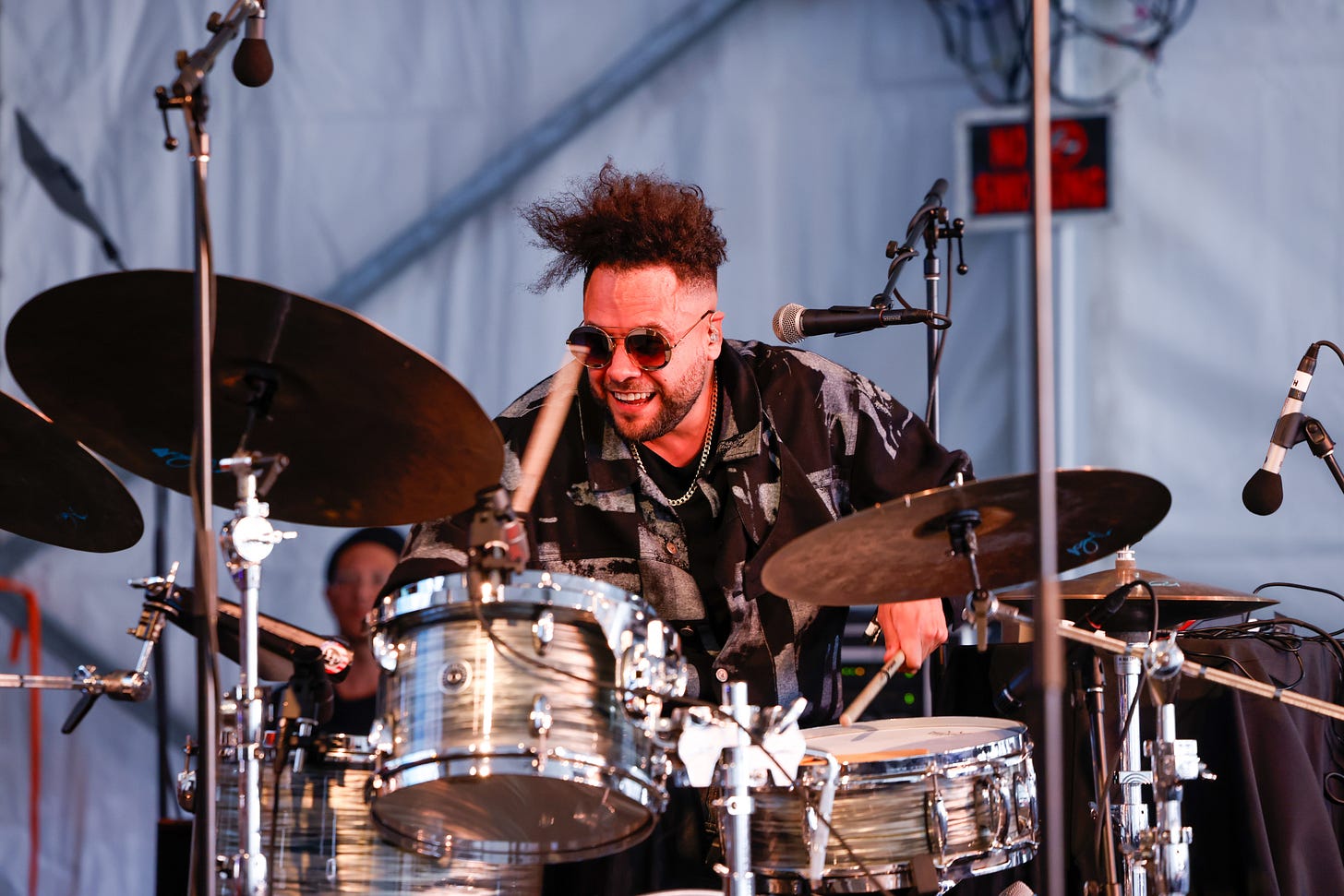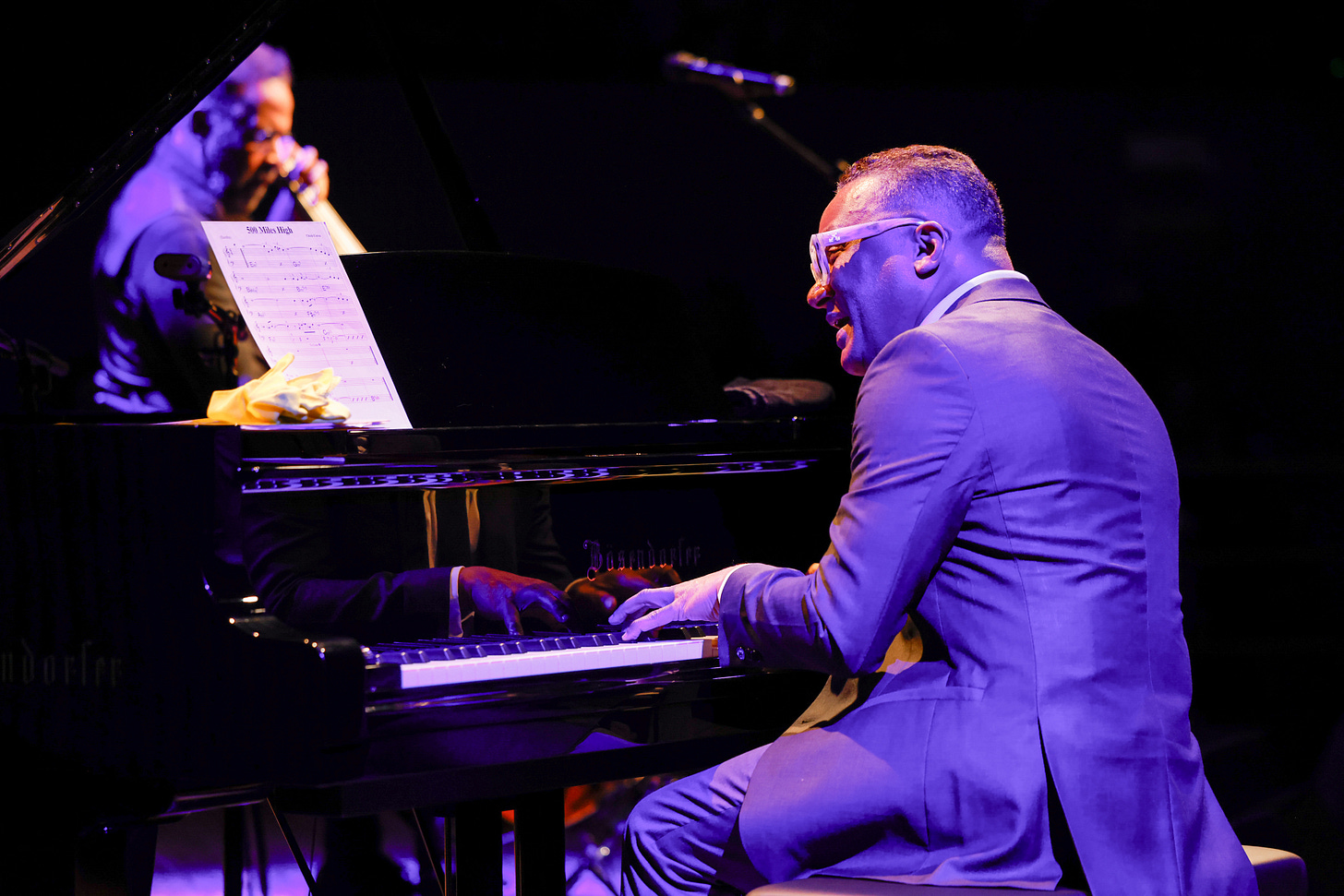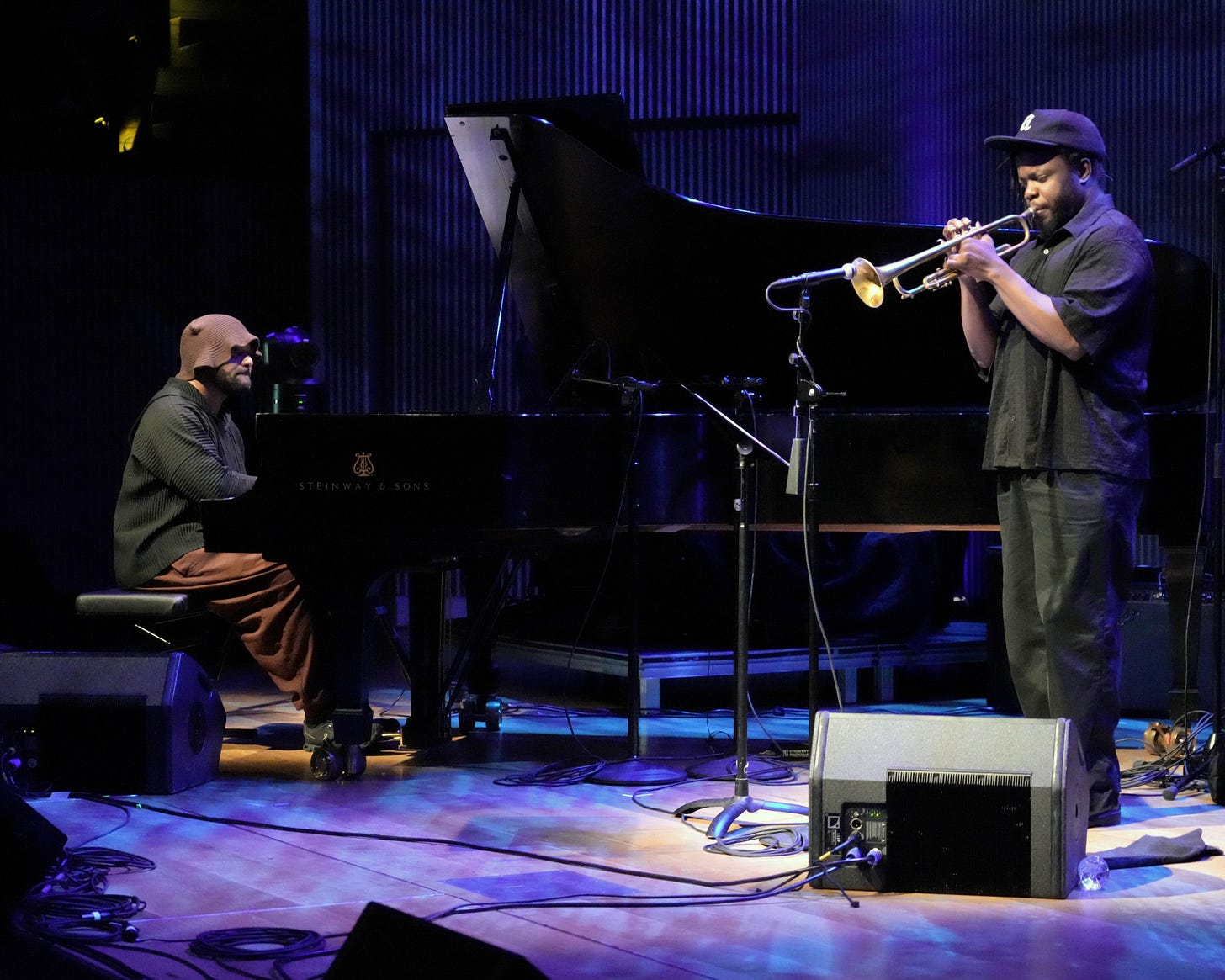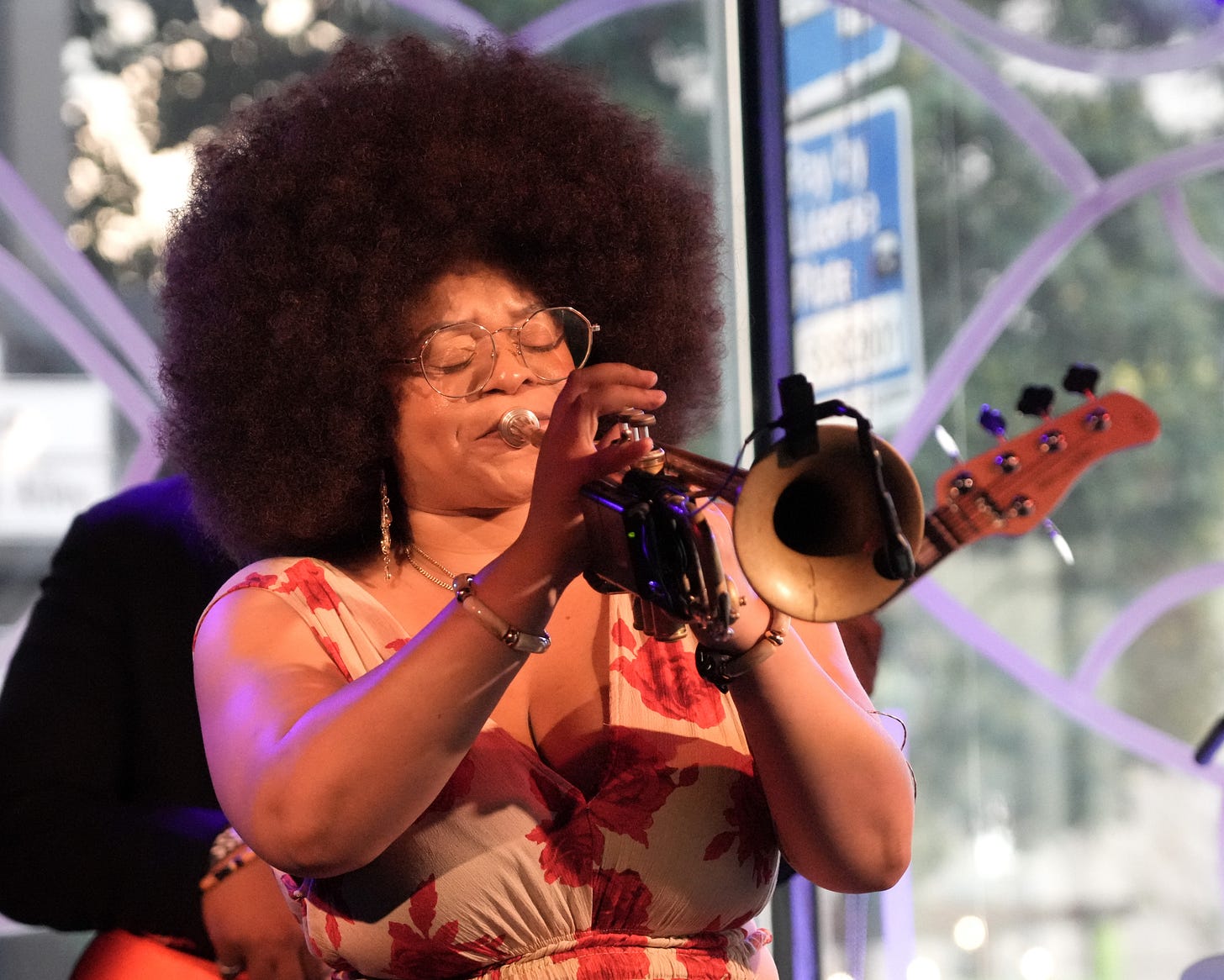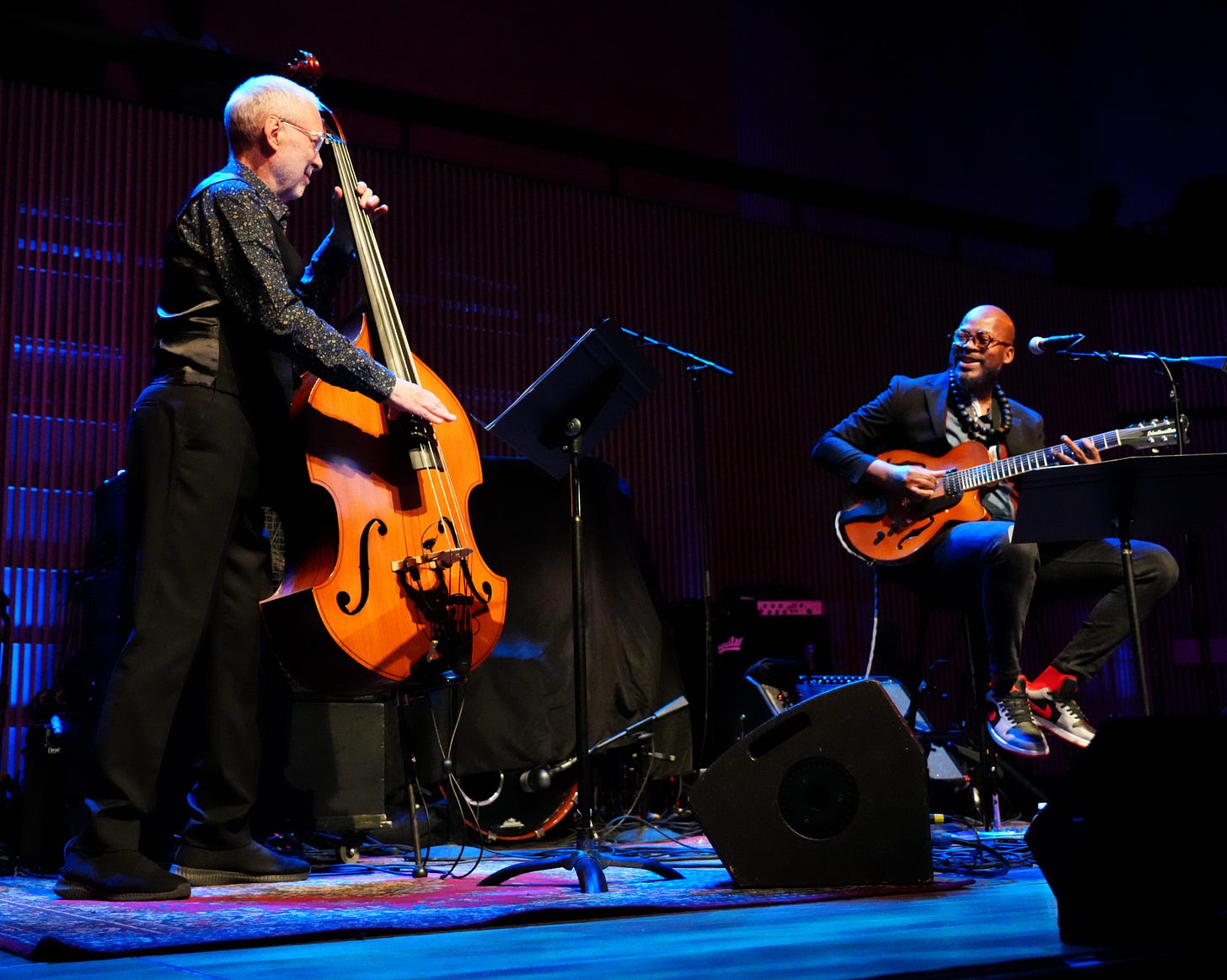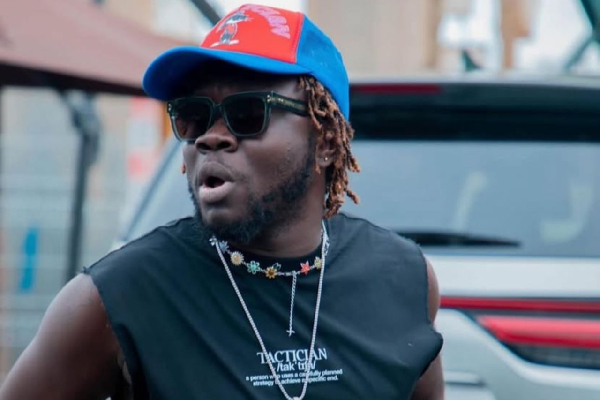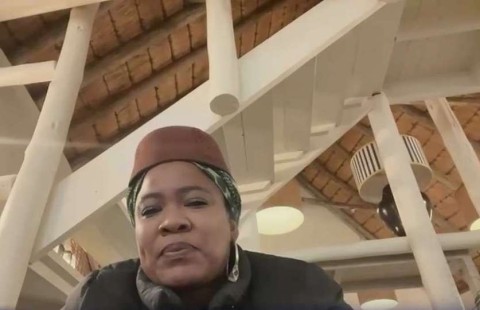The People United - by Nate Chinen - The Gig
This is how welcomed the audience in Miner Auditorium on Saturday afternoon, around the midpoint of the 42nd San Francisco Jazz Festival. He didn’t need to point out that at that very moment, a historic mass of people — some 70,000, according to news reports — was thronging the SF Civic Center Plaza just a few blocks away, at an urgent yet exuberant No Kings Day protest. The accident of timing felt fortuitous. Collective action, eclectic assembly, free exchange: this is what the music models, and what a fest like this is all about.
For nearly all of its history, the San Francisco Jazz Festival has spread a plenitude of concerts across two or three weeks.1 , who founded the fest in 1983, built SFJAZZ as a nonprofit from this foundation, producing the annual affair through 2023, his final year at the helm. Blanchard, who succeeded Kline as Executive Artistic Director, was a driving force behind the festival’s realignment as a focused three-day event — an experiment in critical mass, as he acknowledged in his onstage remarks, intended to “take over the neighborhood for the weekend.”
The , which made a major splash when it opened in 20132, is a natural base of operations for the event, with music running concurrently in its 700-seat Miner Auditorium and 100-capacity Joe Henderson Lab. New to the fest was an outdoor tent and concourse one block down Franklin Street, with a lineup including the fiery alto saxophonist , the iterative-groove outfit , and the dream-logic multi-instrumentalist, producer and singer
Among the 3,500 people who attended the festival over three days, some portion opted for venue-specific passes, choosing either the concert seating and crisp production values of the SFJAZZ Center or the looser, louder option of the festival tent, with its nearby beverage stations and daily rotation of local food trucks. About 22% of festival attendees were first-timers to any SFJAZZ show, and it’s reasonable to assume that they fed the ranks of tent dwellers. (VIP three-day passes sold out, and the festival sold 60% of standard three-day passes. Saturday and Sunday were at capacity.)3
In the tent late on Friday afternoon, I watched a sizable crowd holler its approval at the , led by the guitar ace in Snarky Puppy and The Fearless Flyers, and devoted to a strain of fusion that feels ideally suited to a dogfight montage in Christopher McQuarrie’s Top Gun 3. A little of that vibe goes a long way for me, but I stuck around for drummer-producer , who keeps leveling up as bandleader, broadening the scope even as he sharpens the focus.
Overall knocked me out at Newport last summer. His band there had a wildcard in saxophonist, percussionist and perpetual-motion machine Tomoki Sanders. Here the tenor chair belonged to , a less frenetic but more legibly proficient musical presence, and the difference showed. Along with recent-vintage Kassa classics like “Please Don’t Kill Me” and “Ready to Ball,” the set featured tunes from a forthcoming release titled CREAM, which Overall described as “an album of rap covers from the ‘90s.”4 The concept played out organically, with a version of Eddie Harris’ “Freedom Jazz Dance” (via Miles Smiles) that nodded toward The Pharcyde, and a bossa nova take on “Between the Sheets,” the Isley Brothers hit, that tacitly referenced the core sample in “Big Poppa” by The Notorious B.I.G.
Also sharing material from a forthcoming release was , who’s been working on an ambitious vocalese project around the music of Weather Report. He brought this frame to the , which in its present incarnation has a dangerous front line: trumpeter Mike Rodriguez and two boss tenors, Chris Potter and David Sánchez. The band’s rhythm team — Warren Wolf on vibes and timbales, Edward Simon on piano, Matt Brewer on bass, and Kendrick Scott on drums, with Sánchez pitching in on congas — personalized a Weather Report churn. As for Elling, he handled Wayne Shorter’s melodic line on “Elegant People” as if taking a kite aloft; on “Palladium,” also by Shorter, he dug in to play peekaboo over a staccato funk groove. It was no less stirring to hear his pensive take on Joe Zawinul’s “Current Affairs,” which, as Elling quipped, “is not the most inspiring title for a ballad, now.”
Nowness was both a burden and a gift in Friday’s closing concert by saxophonist and flutist , the distinguished elder among this year’s festival headliners. His Sky Quartet, featuring pianist Jason Moran, bassist Larry Grenadier and drummer Eric Harland, opened with a rubato overture soon recognizable as “God Only Knows,” by the just-departed Brian Wilson — a close friend and collaborator to Lloyd, going back to the early ‘70s. There was breathtaking beauty in his tenor tremble over the searching theme, and Moran met this outpouring with the utmost sensitivity. Later came a collective mind-meld on “Defiant, Tender Warrior,” a standout from Lloyd’s latest triumph, The Sky Will Still Be There Tomorrow. Both of those titles obviously feel even more charged now than they did when the album dropped last year.
Thanks for reading The Gig. This dispatch is free (for a time), so why not pass it along?
Lloyd’s was the richest full-band offering of the festival, whose other astonishments were, for me, more about peer-to-peer exchange. Three marquee duos — each a special event, each a space for unhurried immersion — delivered the weekend’s most transcendent musical highlights.
One was a return engagement: bassist and pianist had played the SFJAZZ Center on at least one prior occasion, in 2023. I’m told (by a subscriber to The Gig who was there) that this concert superseded it. What made it special was a hovering balance of pyrotechnic super-fluency and selfless receptivity. Bookended by staples from Chick Corea’s book for Return to Forever — “500 Miles High” (searching, shimmery) and “No Mystery” (uncorked, spectacular) — the performance invoked Chick again in the encore, a gleefully rampaging “Spain.”
But Clarke and Rubalcaba aren’t just speed demons; each is a gifted rhapsodist in possession of a singing, gorgeous sound. They accessed this side of their interplay on ballads like Thelonious Monk’s “‘Round Midnight” and Horace Silver’s “Peace,” and on a blues by Charlie Haden well suited to the occasion: “Bay City,” which a young Rubalcaba once recorded with Haden and drummer Paul Motian at another fête. There was also a playful take on Dizzy Gillespie’s “Con Alma,” which interpolated a bluesy ostinato that I assume Rubalcaba grafted from his Cuban root system.5
Trumpeter and pianist converged for an even more stunning duo concert, which Fortner called a premiere. What I’d call it, in retrospect, is a profoundly sincere mutual admiration society6 with a stratospheric level of technical and imaginative command. Let’s put it another way, in regionally specific terms: Ambrose and Sullivan achieved the elusive sort of magic tandem that the Golden State Warriors briefly had with Steph Curry and Kevin Durant.
They played a combination of standards and originals, including a heartbreakingly stark “Yesterday” and a weightless version of Akinmusire’s “Owl Song” that was among the single most gorgeous things I heard all weekend. But the duo reached full thrust on a pair of Louis Armstrong / King Oliver touchstones from 1928. “Weather Bird,” which Armstrong recorded as a duo with Earl “Fatha” Hines, let each musician play to certain strengths: Fortner hunched into a rolling, loose-limbed eloquence, while Akinmusire fixated on a phrase in the melody, turning it over in his hands as if to let a jewel catch the light.
The same dynamic extended to “West End Blues,” a landmark from Armstrong’s Hot Five sessions, which Akinmusire approached as a love offering, redrawing the famous cadenza — in particular, the first four notes (A, F, D, G♯) and the triumphant peak (an above-the-staff D) — into myriad new formations, at once heraldic and prismatic. It was playful and purposeful, a musical feat that restored the sense of incipient danger to a recording made almost a century ago.
The Ambrose-and-Sullivan duo also served as a reminder that musicians you may have slotted under the header of “shining young stewards” have a way of growing into their mastery. At one point on Saturday afternoon, I darted between venues to get a taste of two trumpeters at different points on that trajectory, (with his sample-enabled electroacoustic trio) and (digging into the material from his terrific new album Dream Manifest).
A good handful of up-and-comers were booked in the Joe Henderson Lab, where I checked in often, catching a bit of , which I’ll be seeking out elsewhere, and , a trumpeter with a bright, exhortative style. Pianist brought a hypercolor excitement to his set with a trio that featured his mother, who only started playing bass one year ago. And there were two fine male singers, and , each showing gallant poise against a sleek, assertive band. (I’ll have more to say about McDole soon.)
The festival culminated in a euphoric stand by , who peppered her set with hits but also radiant musicianship: check my Instagram for a taste of the keytar solo that formed a delirious coda to “Forget My Nots,” the inevitable encore. The radiant extroversion in her show made for a perfect culmination to the weekend, as a packed house cheered, sang and swayed in time.
Preceding Rushen in the Miner Auditorium was the festival’s third exemplary duo, by bassist and guitarist and vocalist . They were performing music from their recent album United, for only the second time in concert. And as I’ve said from the moment I first heard the album, this is a meeting of souls that can only be experienced live for the full absorbing effect. Holland has a warm, woodsy tone on bass that not only supports Loueke’s nurturing vocals and intricate fretboard filigree; the two musicians relax into their interplay to cast a charming spell. On “Stranger in a Mirror,” one of several custom-fitted Loueke compositions on the album, the agile rhythmic murmurations between him and Holland created the impression of a full rhythm section. Loueke’s percussive vocalizing, annotated with falsetto asides, remains a wonder; at times, struck by the placement of one of Holland’s phrases, he also chuckled happily, introducing a note of contentment that the audience shared.
There were a few other West African-rooted highlights in the Holland-Loueke set, along with a swingy funk tune titled “Hideland,” which capitalized on Holland’s rare talent for making a groove feel both anchored and airy. But one moment I can’t stop thinking about involves the outside composition that gave their album its title: “United,” which Wayne Shorter composed in the early 1960s. Loueke and Holland engaged with the song in a polyrhythmic 12/8 meter, turning it into a study in roving counterpoint — until an upshift into gliding 4/4 swing, when it became a canvas for Loueke’s brisk outpouring of fresh ideas.
“We really felt it appropriate to the time we’re living in,” Loueke said as he introduced “United,” tacitly acknowledging the cruel transgressions of a ruling order so flagrant in its injustice that millions across the country had taken to the streets. I flashed back to the 45 minutes or so I spent at the Civic Center Plaza on Saturday afternoon, and a chant that arose frequently from the crowd: The people united will never be defeated!7
Loueke and Holland are both immigrants; not much more needs to be said about where they stand. But I think it’s worth saying that Loueke ended his intro on a hopeful note, framing musical convocation as a form of solidarity. “The more we get together,” he said, “the more strength we have — just like yesterday.”
